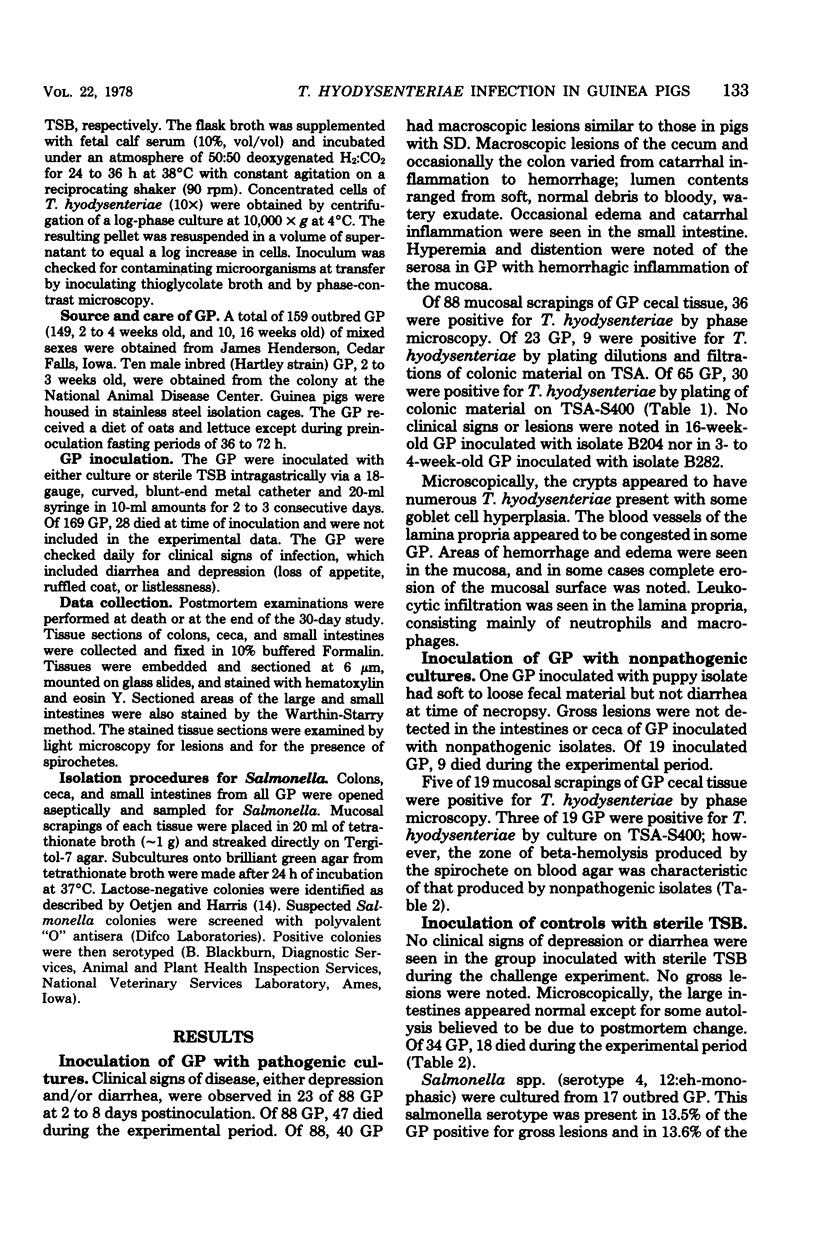Abstract
Outbred and inbred (Hartley strain) guinea pigs (GP) were inoculated intragastrically with pathogenic and nonpathogenic Treponema hyodysenteriae. GP 3 to 16 weeks old received T. hyodysenteriae after a fasting period of 36 to 72 h. Infected GP with pathogenic T. hyodysenteriae developed a diarrheal and/or depressive condition, with mucus but not blood in the feces. Of 88 GP, 40 had gross lesions resembling those of swine dysentery. Lesions were limited mainly to the large intestine. TP used as controls or inoculated with nonpathogenic T. hyodysenteriae did not develop these lesions in the large intestine. These studies suggest that the GP may be used as an animal model for swine dysentery.
Full text
PDF



Selected References
These references are in PubMed. This may not be the complete list of references from this article.
- Alexander T. J., Taylor D. J. The clinical signs, diagnosis and control of swine dysentery. Vet Rec. 1969 Jul 19;85(3):59–63. doi: 10.1136/vr.85.3.59. [DOI] [PubMed] [Google Scholar]
- FRETER R. Experimental enteric Shigella and Vibrio infections in mice and guinea pigs. J Exp Med. 1956 Sep 1;104(3):411–418. doi: 10.1084/jem.104.3.411. [DOI] [PMC free article] [PubMed] [Google Scholar]
- FRETER R. The fatal enteric cholera infection in the guinea pig, achieved by inhibition of normal enteric flora. J Infect Dis. 1955 Jul-Aug;97(1):57–65. doi: 10.1093/infdis/97.1.57. [DOI] [PubMed] [Google Scholar]
- Glock R. D., Harris D. L., Kluge J. P. Localization of spirochetes with the structural characteristics of Treponema hyodysenteriae in the lesions of swine dysentery. Infect Immun. 1974 Jan;9(1):167–178. doi: 10.1128/iai.9.1.167-178.1974. [DOI] [PMC free article] [PubMed] [Google Scholar]
- Harris D. L., Glock R. D., Christensen C. R., Kinyon J. M. Inoculation of pigs with Treponema hyodysenteriae (new species) and reproduction f the disease. Vet Med Small Anim Clin. 1972 Jan;67(1):61–64. [PubMed] [Google Scholar]
- Hughes R., Olander H. J., Williams C. B. Swine dysentery: pathogenicity of Treponema hyodysenteriae. Am J Vet Res. 1975 Jul;36(7):971–977. [PubMed] [Google Scholar]
- Kinyon J. M., Harris D. L., Glock R. D. Enteropathogenicity of various isolates of Treponema hyodysenteriae. Infect Immun. 1977 Feb;15(2):638–646. doi: 10.1128/iai.15.2.638-646.1977. [DOI] [PMC free article] [PubMed] [Google Scholar]
- Kinyon J. M., Harris D. L. Growth in Treponema hyodysenteriae in liquid medium. Vet Rec. 1974 Sep 7;95(10):219–220. doi: 10.1136/vr.95.10.219. [DOI] [PubMed] [Google Scholar]
- Oetjen K. A., Harris D. L. Scheme for systematic identification of aerobic pathogenic bacteria. J Am Vet Med Assoc. 1973 Jul 15;163(2):169–175. [PubMed] [Google Scholar]
- Songer J. G., Kinyon J. M., Harris D. L. Selective medium for isolation of Treponema hyodysenteriae. J Clin Microbiol. 1976 Jul;4(1):57–60. doi: 10.1128/jcm.4.1.57-60.1976. [DOI] [PMC free article] [PubMed] [Google Scholar]
- Taylor D. J., Alexander T. J. The production of dysentery in swine by feeding cultures containing a spirochaete. Br Vet J. 1971 Nov;127(11):58–61. doi: 10.1016/s0007-1935(17)37282-2. [DOI] [PubMed] [Google Scholar]


